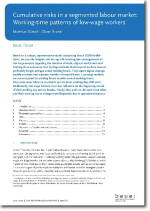Cumulative risks in a segmented labour market: Working-time patterns of low-wage workers
Based on a unique, representative study comprising about 20,000 individuals, we provide insights into the specific working-time arrangements of low-wage earners regarding the duration of work, atypical work hours and working-time autonomy. Our findings indicate that low-paid workers have significantly longer average actual working hours. They report higher average weekly overtime and a greater number of unpaid hours. Low-wage workers are more exposed to working hours outside normal working hours. They work more often on weekends and do more rotating day-shift work. Additionally, low-wage workers have less influence on the beginning or end of their working day and on breaks. Finally, they work on demand more often and their working hours change more frequently due to operational reasons.
Bibliographic information
Title: Cumulative risks in a segmented labour market: Working-time patterns of low-wage workers.
2021. pages: 27, PDF file, DOI: 10.21934/baua:focus20210505
